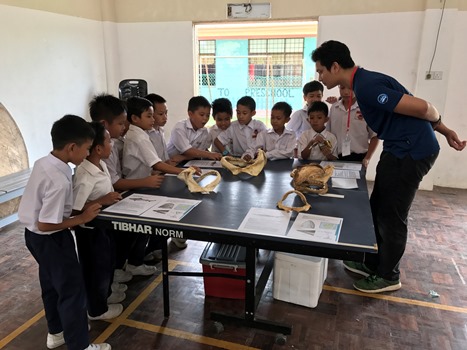 TUESDAY, 31 JULY - Social media was abuzz in the first week of July (2018) with yet appalling news of a dead Whale Shark reportedly accidentally caught in a fisherman’s net.
TUESDAY, 31 JULY - Social media was abuzz in the first week of July (2018) with yet appalling news of a dead Whale Shark reportedly accidentally caught in a fisherman’s net.
The site of the incident was a coastal village in Mukah, in neighbouring Sarawak.
Unlike other large predatory sharks, the Whale Shark is a rather gentle but generally misunderstood large vertebrate.
Described by marine ecologists as charismatic, the reason this unique ocean wildlife swim to near the sea surface is simply to feed.
Their main food is called planktons – microscopic creatures which consist of primary producers and primary consumers.
Borneo indeed has a high biodiversity of sharks and rays, with over 100 species scientifically recorded from its waters, including fresh and brackish water habitats.
A biodiversity monitoring research program spanning 20 years, conducted by Universiti Malaysia Sabah researchers, found that at present, the sharks of Sabah’s waters is dominated by bamboo sharks and coral catsharks.
According to Dr. Mabel Manjaji Matsumoto, leader of the research project funded by Save Ours Seas Foundation, these demersal or bottom dwelling sharks appear to have replaced the larger predatory coastal inshore species.
Such shift in species dominance, especially from a larger to smaller species is what is termed by fisheries scientists as a process of “fishing down the food web”.
The process describes of large predatory (fish) species as having been depleted due to fishing pressure, where the fisheries are increasingly turning to the smaller and previously rejected species.
Large predatory sharks have an essential role in keeping the marine ecosystem healthy and productive.
They do this by selectively preying on the weaker creatures and thus keeping diseases at bay.
Removal and changes in number of apex species will affect the marine food web.
Sharks are readily distinguished from the teleost or bony fishes by either having their body entirely or partially covered by rough teeth-like scales.
The internal skeleton of sharks and rays is entirely formed of cartilage.
Sharks and rays also differ from teleost in the reproductive strategy, in which the former mature at a generally larger size, and produce fewer but more developed young.
In celebration of Shark Awareness Day 2018, we invite you to consider adopting actions that impact sharks in a positive way.
At Universiti Malaysia Sabah through the Endangered Marine Species Research Unit, researchers actively and continuously conduct research projects in an effort to conserve sharks.
This includes organising shark awareness programs, outreaching primarily to elementary school children in coastal rural regions of Sabah.